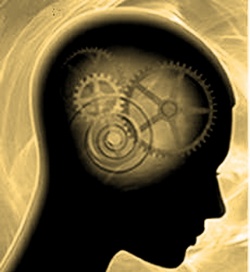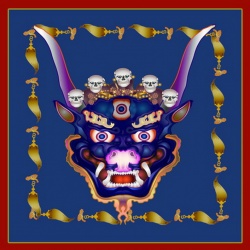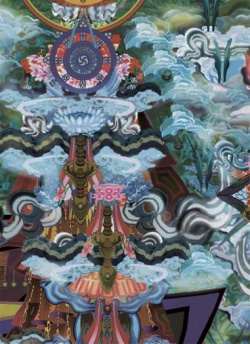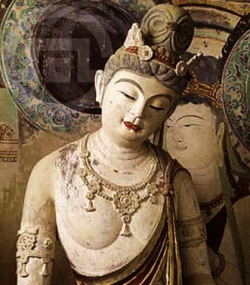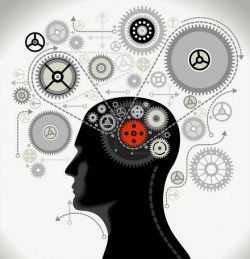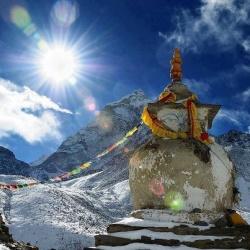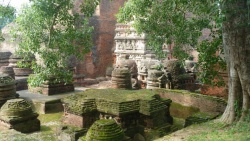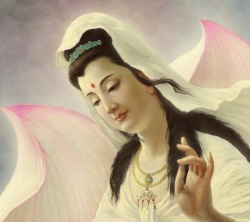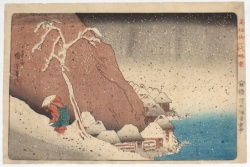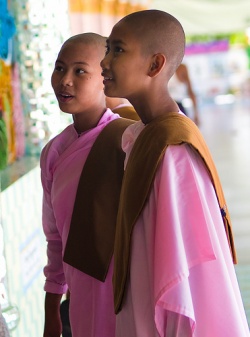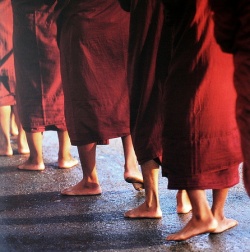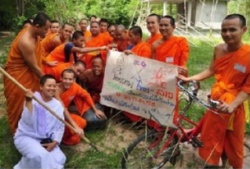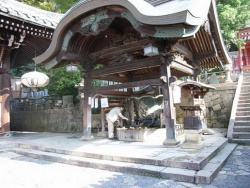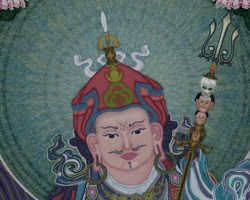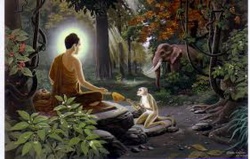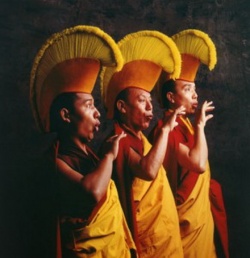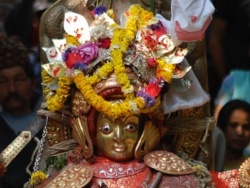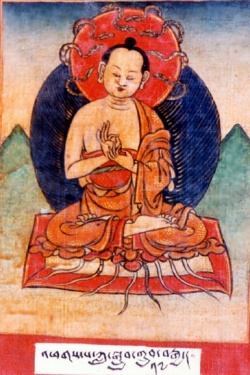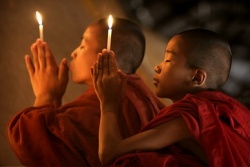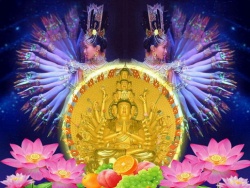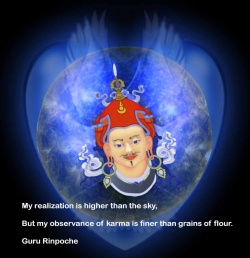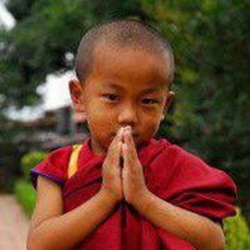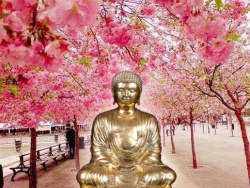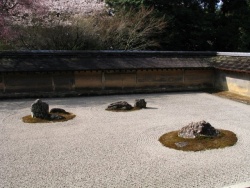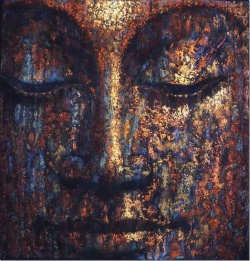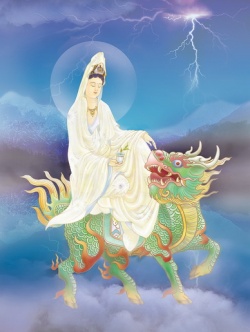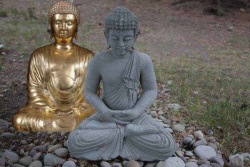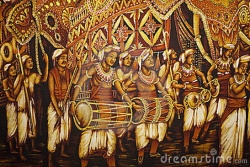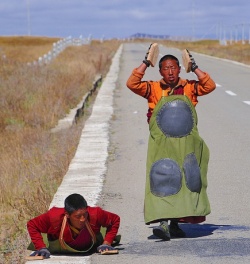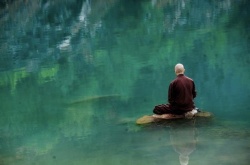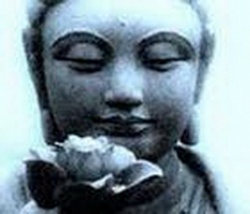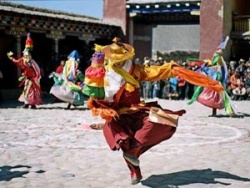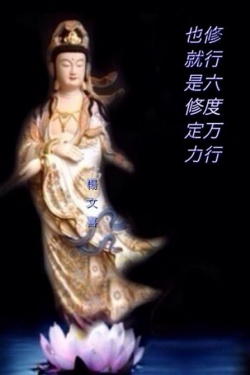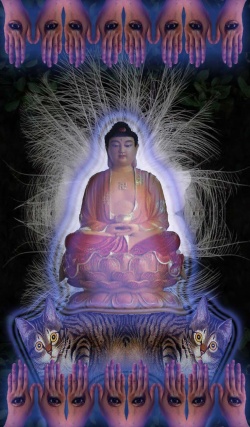Kōan
A kōan (公案?)play /ˈkoʊ.ɑːn/; Chinese: 公案; pinyin: gōng'àn; Korean: 공안 (kong'an); Vietnamese: công án) is a story, dialogue, question, or statement, which is used in Zen-practice to provoke the "great doubt", and test a student's progress in Zen practice.
Etymology
The Japanese term kōan is the on'yomi Sino-Japanese reading of Chinese gong'an (Chinese: 公案; pinyin: gōng'àn; Wade–Giles: kung-an; literally "public case"), which means "(complicated) legal case; table to hold documents of a case; (Buddhist) koan (knotty problem in Zen);
(traditional) detective stories; a much discussed issue; a sensational affair."
This word compounds gong (公) "public affairs; official duties; common; collective; fair; impartial; make public" and an (案) "(archeology) rectangular stand for supporting wine vessels; table; desk; (law) case; record; file."
According to the Yuan Dynasty Zen master Zhongfeng Mingben (中峰明本 1263–1323), gōng'àn abbreviates gōngfǔ zhī àndú (公府之案牘, Japanese kōfu no antoku –
literally the andu "official correspondence; documents; files" of a gongfu "government post"), which referred to a "public record" or the "case records of a public law court" in Tang-dynasty China.
Kōan/gong'an thus serves as a metaphor for principles of reality beyond the private opinion of one person, and a teacher may test the student's ability to recognize and understand that principle.
Commentaries in kōan collections bear some similarity to judicial decisions that cite and sometimes modify precedents.
An article by T. Griffith Foulk claims
Gong'an was itself originally a metaphor — an article of furniture that came to denote legal precedents.
For example, Di Gong'an (狄公案) is the original title of Celebrated Cases of Judge Dee, the famous Chinese detective novel based on a historical Tang dynasty judge.
Similarly, Zen kōan collections are public records of the notable sayings and actions of Zen disciples and masters attempting to pass on their teachings.
Origins and development
China
Commenting on old cases
Gongans developed during the Tang Dynasty (618-907) from the recorded sayings collections of Chán-masters, which quoted many stories of "a famous past Chán figure's encounter with disciples or other interlocutors and then offering his own comment on it".
Those stories and the accompanying comments were used to educate students, and broaden their insight into the Buddhist teachings.
Those stories came to be known as gongan, "public cases".
Such a story was only considered a gongan when it was commented upon by another Chán-master.
This practice of commenting on the words and deeds of past masters confirmed the master's position as awakened master in a lineage of awakened masters of the past.
Literary practice ; Koan practice
Koan practice developed from a literary practice, styling snippets of encounter-dialogue into well-edited stories. It arose in interaction with "educated literati".
There were dangers involved in such a literary approach, such as fixing specific meanings to the cases. Dahui Zonggao is even said to have burned the woodblocks of the Blue Cliff Record, for the hindrance it had become to study of Chán by his students Kōan literature was also influenced by the pre-Zen Chinese tradition of the "literary game" — a competition involving improvised poetry.
The style of writing of Zen texts has been influenced by "a variety of east Asian literary games":
- Indirect references, such as titling a poem with one topic and composing a verse that seems on the surface to be totally unrelated;
- Inventive wordplay based on the fact that kanji (Chinese characters) are homophonic and convey multiple, often complementary or contradictory meanings;
- Linking the verses in a sustained string based on hidden points of connection or continuity, such as seasonal imagery or references to myths and legends.
Observing the phrase - koan
During the Song Dynasty (960-1297) the use of gongans took a decisive turn.
Dahui Zonggao (1089–1163) introduced the use of k'an-hua, "observing the phrase".
In this practice students were to observe (k'an) or concentrate on a single word or phrase (hua-t'ou), such as the famous mu of the mu-koan.
In the eleventh century this practice had become common.
A new literary genre developed from this tradition as well. Collections of such commented cases were compiled which consisted of the case itself, accompanied by verse or prose commentary.
Tahui's invention was aimed at balancing the insight developed by reflection on the teachings with developing samatha, calmness of mind.
Ironically, this development became in effect silent illumination, a "[re-absorbing] of koan-study into the "silence" of meditation (ch'an)".
It lead to an rejection of Buddhist learning:
- Some extent of Buddhist learning could easily have been recognized as a precondition for sudden awakening in Ch'an. Sung masters, however, tended to take the rejection literally and nondialectically.
In effect, what they instituted was a form of Zen fundamentalism:
the tradition came to be increasingly anti-intellectual in orientation and, in the process, reduced its complex heritage to simple formulae for which literal interpretations were thought adequate.
This development left Chinese Chán vulnerable for criticisms by neo-Confucianism, which developed after the Sung Dynasty. Its anti-intellectual rhetoric was no match for the intellectual discourse of the neo-Confucianists.
Interaction
The recorded encounter dialogues, and the koan collections which derived from this genre, mark a shift from solitary practice to interaction between master and student:
- The essence of enlightenment came to be identified with the interaction between masters and students.
Whatever insight dhyana might bring, its verification was always interpersonal.
In effect, enlightenment came to be understood not so much as an insight, but as a way of acting in the world with other people
This mutual enquiry of the meaning of the encounters of masters and students of the past gave students a role model:
- One looked at the enlightened activities of one's lineal forebears in order to understand one's own identity [...] taking the role of the participants and engaging in their dialogues instead
Kōan training requires a qualified teacher who has the ability to judge a disciple's depth of attainment.
In the Rinzai Zen school, which uses kōans extensively, the teacher certification process includes an appraisal of proficiency in using that school's extensive kōan curriculum.
Contemporary koan-use
In China and Korea, "observing the phrase", still is the sole form of koan-practice, though Seung Sahn used the Rinzai-style of koan-practice in his Kwan Um School of Zen.
Japan
Japanese Zen, both Rinzai and Soto, took over the use of koan-study and -commenting.
In Soto-Zen, koan commentary was not linked to seated meditation.
Koan manuals
When the Chán-tradition was introduced in Japan Japanese monks had to master the Chinese language and specific expressions used in the koan-training.
The desired "spontaneity" expressed by enlightened masters required a thorough study of Chinese language and poetry.
Japanese Zen imitated the Chinese "syntax and stereotyped norms".
In the officially recognized monasteries belonging to the Gozan (Five Mountain System) the Chinese system was fully continued.
Senior monks were supposed to compose Chinese verse in a complex style of matched counterpoints known as bien-li wen.
It took a lot of literary and intellectual skills for a monk to succeed in this system.
The Rinka-monasteries, the provincial temples with less control of the state, laid less stress on the correct command of the Chinese cultural idiom.
These monasteries developed "more accessible methods of koan instruction". It had three features:
- A standardized koan-curriculum;
- A standardized set of answers based on stereotypes Chinese sayings;
- A standardized method of secretly guiding students through the curriculum of koan and answers.
By standardizing the koan-curriculum every generation of students proceeded to the same series of koans.
Students had to memorize a set number of stereotyped sayings, agyo, "appended words". The proper series of responses for each koan were taught by the master in private instruction-sessions to selected individual students who would inherit the dharma lineage.
Missanroku and missancho, "Records of secret instruction" have been preserved for various Rinzai-lineages.
They contain both the koan-curricula and the standardized answers.
In Soto-Zen they are called monsan, an abbreviation of monto hissan, "secret instructions of the lineage".
The monsan follow a standard question-and-answer format.
A series of questions is give, to be asked by the master. The answers are also given by the master, to be memorized by the student.
Contemporary koan curriculum
In the eighteenth century the Rinzai-school became dominated by the legacy of Hakuin, who laid a strong emphasisd on koan-study as a means to gain kensho and further develop this primary insight.
There are two curricula being used within Rinzai, derived from the principal heirs of Rinzai: the Takuju curriculum, and the Inzan curriculum.
Suppression in the Soto-school
During the late eighteenth and nineteenth century the tradition of koan-commentary became suppressed in the Soto-school, due to a reform movement that sought to standardise the procedures for dharma transmission.
One reason for suppressing the koan-tradition in the Soto-school may have been to highlight the differences with the Rinzai-school, and create a clear identity.
This movement also started to venerate Dogen as the founding teacher of the Soto-school.
His teachings became the standard for the Soto-teachings, neglecting the fact that Dogen himself made extensive use of koan-commentary.
Doctrinal background of Koan
The popular western understanding sees kōan as referring to an unanswerable question or a meaningless statement.
However, in Zen practice, a kōan is not meaningless, and not a riddle or a puzzle.
Teachers do expect students to present an appropriate response when asked about a kōan.
Koans are also understood as pointers to an unmediated "Pure Consciousness", devoid of cognitive activity. Victor Hori criticizes this understanding:
- [A] pure consciousness without concepts, if there could be such a thing, would be a booming, buzzing confusion, a sensory field of flashes of light, unidentifiable sounds, ambiguous shapes, color patches without significance. This is not the consciousness of the enlightened Zen master.
According to Hori, a central theme of many koans is the 'identity of opposites':
- Koan after koan explores the theme of nonduality.
Hakuin's well-known koan, "Two hands clap and there is a sound, what is the sound of one hand?" is clearly about two and one.
The koan asks, you know what duality is, now what is nonduality?
In "What is your original face before your mother and father were born?" the phrase "father and mother" alludes to duality.
This is obvious to someone versed in the Chinese tradition, where so much philosophical thought is presented in the imagery of paired opposites.
The phrase "your original face" alludes to the original nonduality.
Comparable statements are: "Look at the flower and the flower also looks"; "Guest and host interchange".
Koan-practice
Study of kōan literature is common to all schools of Zen, though with varying emphases and curriculae.
The Rinzai-school uses extensive koan-curricula, checking questions, and jakogo ("capping phrases", quotations from Chinese poetry) in its use of koans.
The Sanbo Kyodan, and it's western derivates of Taizan Maezumi and the White Plum Asanga, also use koan-curricula, but have omitted the use of capping phrases.
In Chinese Chán and Korean Seon, the emphasis is on Hua Tou, the study of one koan throughout one's lifetime.
In Japanese Soto-Zen, the use of koans has been abandoned since the late eighteenth and nineteenth century.
Hua-tou or breakthrough-koan
In the Rinzai-school, the Sanbo Kyodan, and the White Plum Asanga, koan practice starts with the assignment of a hosshi or "break-through koan", usually the mu-koan or "the sound of one hand clapping".
In Chinese Chán and Korean Seon, various koan can be used for the hua-tou practice.
Students are instructed to concentrate on the "word-head", like the phrase "mu".
In the Wumenguan (Mumonkan), public case #1 ("Zhaozhou's Dog"), Wumen (Mumon) wrote:
- ...concentrate yourself into this 'Wú'... making your whole body one great inquiry. Day and night work intently at it. Do not attempt nihilistic or dualistic interpretations."
Arousing this great inquiry or "Great Doubt" is an essential element of kōan practice.
It builds up "strong internal pressure (gidan), never stopping knocking from within at the door of [the] mind, demanding to be resolved", To illustrate the enormous concentration required in kōan meditation, Zen Master Wumen commented,
- It is like swallowing a red-hot iron ball. You try to vomit it out, but you can't.
Analysing the koan for its literal meaning won't lead to insight, though understanding the context from which koans emerged can make them more intelligible.
For example, when a monk asked Zhaozhou (Joshu) "does a dog have Buddha-nature or not?", the monk was referring to the understanding of the teachings on Buddha-nature, which were understood in the Chinese context of absolute and relative reality.
Insight
The continuous pondering of the break-through koan (shokan) or Hua Tou, "word head", leads to kensho, an initial insight into "seeing the Buddha-nature.
The aim of the break-through koan is to see the "nonduality of subject and object":
Realization of this is the insight; the response to the koan [...] Subject and object - this is two hands clapping.
When the monk realizes that the koan is not merely an object of consciousness but is also he himself as the activity of seeking an answer to the koan, then subject and object are no longer separate and distinct [...] This is one hand clapping.
Various accounts can be found which describe this "becoming one" and the resulting breakthrough:
- I was dead tired. That evening when I tried to settle down to sleep, the instant I laid my head on the pillow, I saw: "Ah, this outbreath is Mu!" Then: the in-breath too is Mu!" Next breath, too:
Mu! Nex breath: Mu, Mu! "Mu, a whole sequence of Mu! Croak, croak; meow, meow - these too are Mu! The bedding, the waal, the column, the sliding-door - these too are Mu! This, that and everything is Mu! Ha ha! Ha ha ha ha Ha! that roshi is a rascal! He's always tricking people with his 'Mu, Mu, Mu'!...
Testing insight
Demonstrating insight
Insight has to be demonstrated. A mere "answer" to a koan is not sufficient.
The teacher is not looking for a specific answer, but for evidence that the disciple has grasped the state of mind expressed by the kōan itself. Appropriate responses to a kōan vary, since different teachers may demand different responses to a given kōan, and the answers may vary by circumstance.
Sassho - Checking Questions
Teachers may probe students about their kōan practice using sassho, "checking questions" to validate their satori (understanding) or kensho (seeing the nature).
For the mu-koan and the clapping hand-koan there are twenty to hundred checking questions, depending on the teaching lineage.
The checking questions serve to deepen the insight of the student, but also to test his or her understanding.
Jakugo - Capping phrases
In the Rinzai-school, passing a koan and the checking questions has to be supplemented by jakugo, "capping phrases", citations of Chinese poetry to demonstrate the insight.
Students can use collections of those citations, instead of composing poetry themselves.
Post-satori practice
After the initial insight further practice is necessary, to deepen the insight and learn to express it in daily life.
In Chinese Chán and Korean Seon, this further practice consists of further pondering of the same Hua Tou.
In Rinzai-Zen, this further practice is undertaken by further koan-study, for which elaborate curriculae exist. In Soto-Zen, Shikantaza is the main practice for deepening insight.
Varieties in koan-practice
Chinese Chán and Korean Seon
In Chinese Chán and Korean Seon, the primary form of Koan-study is k'an-hua, "reflection on the koan", also called Hua Tou, "word head".
In this practice, a fragment of the koan, such as "mu", or a "what is"-question is used by focusing on this fragment and repeating it over and over again:
- Who is it who now repeats the Buddha's name?
- Who is dragging this corpse about?
- What is this?
- What is it?
- What was the original face before my father and mother were born?
- Who am I?
The student is assigned only one hua-tou for a lifetime.
In contrast to the similar sounding "who am I?" question of Ramana Maharshi, hua-tou involves raising "great doubt":
- This koan becomes a touchstone of our practice: it is a place to put our doubt, to cultivate great doubt, to allow the revelation of great faith, and to focus our great energy.
Japanese Rinzai
Kōan practice is particularly important among Japanese practitioners of the Rinzai sect.
Importance of koan-study
This importance is reflected in writings in te Rinzai-school on the koan-genre. Zhongfeng Mingben (中峰明本, Wade Giles:Chung-feng Ming-pen; Jpn. Chūhō Myōhon) (1263-1323), a Chinese Chán-master who lived at the beginning of the Yuan Dynasty, revitalized the Rinzai-tradition,
and put a strong emphasis on the use of koans.
He saw the kung-ans as "work of literature that] should be used as objective, universal standards to test the insight of monks who aspired to be recognized as Ch'an masters":
- The koans do not represent the private opinion of a single man, but rather the hundreds and thousands of bodhisattvas of the three realms and ten directions.
This principle accords with the spiritual source, tallies with the mysterious meaning, destroys birth-and-death, and transcends the passions.
It cannot be understood by logic it cannot be transmitted in words; it cannot be explained in writing; it cannot be measured by reason.
It is like the poisoned drum that kills all who hear it, or like a great fire that consumes all who come near it.
What is called "the special transmission of the Vulture Peak" was the transmission of this; what is called the "direct pointing of Bodhidharma at Shao-lin-ssu" is this.
Musō Soseki (1275-1351), a Japanese contemporary of Zhongfeng Mingben, relativized the use of koans.
The study of koans had become popular in Japan, due to the influence of Chinese masters such as Zhongfeng Mingben.
Despite belonging to the Rinzai-school, Musō Soseki also made extensive use of richi (teaching), explaining the sutras, instead of kikan (koan).
According to Musō Soseki, both are upaya, "skillfull means" meant to educate students.
Musō Soseki called both shōkogyu, "little jewels", tools to help the student to attain satori.
Koan curricula
In Rinzai a gradual succession of koans is being studied. There are two curricula being used within Rinzai, derived from the principal heirs of Rinzai:
the [[Takuju curriculum, and the Inzan curriculum.
Koan practice starts with the shokan, or "first barrier", usually the mu-koan or the koan "What is the sound of one hand clapping?"
After having attained kensho, students continue their practice investigating subsequent koans.
In the Takuju-school, after breakthrough students work through the Gateless Gate (Mumonkan), the Blue Cliff Record (Hekigan-roku), the Entangling Vines (Shumon Kattoshu), and the Collection of Wings of the Blackbird (Chin'u shu).
The Inzan-school uses its own internally generated list of koans.
Hakuin's descendants developed a fivefold classification system
They reveal the dharmakaya, or Fundamental. They introduce "the undifferentitated and the unconditional".
- Kikan, dynamic action koans, help to understand the phenomenal world as seen from the awakened point of view; Where hosshin koans represent tai, substance, kikan koans represent yu, function.
- Gonsen, explication of word koans, aid to the understanding of the recorded sayings of the old masters.
They show how the Fundamental, though not depending on words, is nevertheless expressd in words, without getting stuck to words.
- Hachi Nanto, eight "difficult to pass" koans.
There are various explanations for this category, one being that these koans cut off clinging to the previous attainment.
They create another Great Doubt, which shatters the self attained through satori.
It is uncertain which are exactly those eight koans.
Hori gives various sources, which altogether give ten hachi nanto koans:
- -Miura and Sasaki
- -Nansen’s Flower (Hekigan-roku Case 40)
- -A Buffalo Passes the Window (Mumonkan Case 38)
- -Sōzan’s Memorial Tower (Kattō-shō Case 140)
- -Suigan’s Eyebrows (Hekigan-roku Case 8)
- -Enkan’s Rhinoceros Fan (Hekigan-roku Case 91)
- -Shimano:
- -The Old Woman Burns the Hut (Kattō-shō Case 162)
- -Asahina Sōgen:
- -Goso Hōen’s “Hakuun Said ‘Not Yet’” (Kattō-shō Case 269)
- -Shuzan’s Main Cable (Kattō-shō Case 280).
- -Akizuki:
- -Miura and Sasaki
- Goi jujukin koans, the Five Ranks of Tozan and the Ten Grave Precepts.
According to Akizuki there was an older classification-system, in which the fifth category was Kojo, "Directed upwards".
This category too was meant to rid the monk of any "stink of Zen".
The very advanced practitioner may also receive the Matsugo no rokan, "The last barrier, and Saigo no ikketsu, "The final confirmation".
"The last barrier" when one leaved the training hall, for example "Sum up all of the records of Rinzai in one word!" It is not meant to be solved immediately, but to be carried around in order to keep practising. "the final confirmation" may be another word for the same kind of koan.
Post-satori practice
Completing the koan-curriculum in the Rinzai-schools asks for an extensive command of Chinese poetry and literary skills:
- [D]isciples today are expected to spend a dozen pr more years with a master to complete a full course of training in koan commentary. Only when a master is satisfied that a disciple can comment appropriately on a wide range of old cases will he recognize the latter as a dharma heir and give him formal "proof of transmission" (J. inka shomei).
Thus, in reality, a lot more than satori is required for one to be recognized as a master (J. shike, roshi) in the Rinzai school of Zen at present.
The accepted proof of satori is a set of literary and rhetorical skills that takes many years to acquire.
After completing the koan-training, Gogo no shugyo, post-satori training is necessary:
After the student has solved all koans, he can leave the sōdō and live on his own, but he is still not considered a roshi.
For this he has to complete another ten years of training, called "go-go-no-shugyō" in Japanese.
Literally, this means "practice after satori/enlightenment", but Fukushima preferred the translation "special practice".
Fukushima would explain that the student builds up a "religious personality" during this decade.
I would say it is a kind of period that functions to test if the student is actually able to live in regular society and apply his koan understanding to daily life, after he has lived in an environment that can be quite surreal and detached from the lives of the rest of humanity.
Usually, the student lives in small parish temple during this decade, not in a formal training monastery.
Breathing practices
Hakuin Ekaku recommended preparing for kōan practice by concentrating on qi breathing and its effect on the body's center of gravity, called the dantian or "hara" in Japanese — thereby associating kōan practice with pre-existing Taoist and Yogic chakra meditative practices.
Japanese Soto
Though few Soto practitioners concentrate on kōans during meditation, the Soto sect has a strong historical connection with kōans, since many kōan collections were compiled by Soto priests.
During the 13th century, Dōgen, founder of the Soto sect in Japan, quoted 580 kōans in his teachings.
He compiled some 300 kōans in the volumes known as the Greater Shōbōgenzō.
Dōgen wrote of Genjokōan, which points out that everyday life experience is the fundamental kōan.
However, according to Michel Mohr,
- ...kōan practice was largely expunged from the Soto school through the efforts of Gentō Sokuchū (1729–1807), the eleventh abbot of Entsuji, who in 1795 was nominated abbot of Eiheiji".
Sanbo Kyodan and White Plum Asanga
The Sanbo Kyodan school and the White Plum Asanga, which originated with the Soto-priest Hakuun Yasutani, incorporates koan-study.
The Sanbo kyodan places great emphasis on kensho, initial insight into one's true nature, as a start of real practice.
It follows the so-called Harada-Yasutani koan-curriculum, which is derived from Hakuin's student Takuju.
It is a shortened koan-curriculum, in which the socalled "capping phrases" are removed. The curriculum takes considerably less time to study than the Takuju-curriculum of Rinzai.
To attain kensho, most students are assigned the mu-koan.
After breaking through, the student first studies twenty-two "in-house" koans, which are "unpublished and not for the general public", but are nevertheless published and commented upon.
There-after, the students goes through the Gateless Gate (Mumonkan), the Blue Cliff Record, the Book of Equanimity, and the Record of Transmitting the Light.
The koan-curriculum is completed by the Five ranks of Tozan and the precepts.
Classical kōan collections
Kōans collectively form a substantial body of literature studied by Zen practitioners and scholars worldwide.
Kōan collections commonly referenced in English include:
- -The Blue Cliff Record (Chinese: Bìyán Lù; Japanese: Hekiganroku), 12th century;
- -The Book of Equanimity (also known as the Book of Serenity; Chinese: Cōngróng Lù; Japanese: Shoyoroku), 12th century;
- -The Gateless Gate (also known as The Gateless Barrier; Chinese: Wúménguān; Japanese: Mumonkan) collected during the 13th century).
In these and subsequent collections, a terse "main case" of a kōan often accompanies prefatory remarks, poems, proverbs and other phrases, and further commentary about prior emendations.
The Blue Cliff Record
The Blue Cliff Record (Chinese: 碧巖錄 Bìyán Lù; Japanese: Hekiganroku) is a collection of 100 kōans compiled in 1125 by Yuanwu Keqin (圜悟克勤 1063–1135).
The Book of Equanimity
The Book of Equanimity or Book of Serenity (Chinese: 從容録; Japanese: 従容録 Shōyōroku) is a collection of 100 Kōans compiled in the 12th century by Hongzhi Zhengjue (Chinese: 宏智正覺; Japanese: Wanshi Shōgaku) (1091–1157).
The full title is The Record of the Temple of Equanimity With the Classic Odes of Venerable Tiantong Jue and the Responsive Commentary of Old Man Wansong 《萬松老評唱天童覺和尚 頌古從容庵錄》(Ch. Wansong Laoren Pingchang Tiantong Jue Heshang Songgu Congrong An Lu)(Taisho Tripitaka Vol. 48, No. 2004)
The Gateless Gate
The Gateless Gate (Chinese: 無門關 Wumenguan; Japanese: Mumonkan) is a collection of 48 kōans and commentaries published in 1228 by Chinese monk Wumen (無門) (1183–1260).
The title may be more accurately rendered as Gateless Barrier or Gateless Checkpoint).
Five kōans in the collection derive from the sayings and doings of Zhaozhou Congshen, (transliterated as Chao-chou in Wade-Giles and pronounced Jōshū in Japanese).
The True Dharma Eye
The True Dharma Eye 300 (Shōbōgenzō Sanbyakusoku) is a collection of 300 kōans compiled by Eihei Dōgen.
Other kōan collections compiled and annotated by Soto priests include:
- -The Iron Flute (Japanese: Tetteki Tosui, compiled by Genro in 1783)
- -Verses and Commentaries on One Hundred Old Cases of Tenchian (Japanese: Tenchian hyakusoku hyoju, compiled by Tetsumon in 1771.)
Examples of traditional kōans
Does a dog have Buddha-nature
- A monk asked Zhàozhōu, "Does a dog have Buddha nature or not?" Zhaozhou said, "Wú".
("Zhaozhou" is rendered as "Chao-chou" in Wade-Giles, and pronounced "Joshu" in Japanese.
"Wu" appears as "mu" in Japanese, meaning "no", "not", "nonbeing", or "without" in English.
This is a fragment of Case #1 of the Wúménguān.
However, another koan presents a longer version, in which Zhaozhou answered "yes" in response to the same question asked by a different monk: see Case #18 of the Book of Serenity.)
The sound of one hand clapping
Victor Hori comments:
- ...in the beginning a monk first thinks a kōan is an inert object upon which to focus attention; after a long period of consecutive repetition, one realizes that the kōan is also a dynamic activity, the very activity of seeking an answer to the kōan.
The kōan is both the object being sought and the relentless seeking itself.
In a kōan, the self sees the self not directly but under the guise of the kōan...
When one realizes ("makes real") this identity, then two hands have become one. The practitioner becomes the kōan that he or she is trying to understand. That is the sound of one hand.
Original Face
Huìnéng asked Hui Ming, "Without thinking of good or evil, show me your original face before your mother and father were born." (This is a fragment of case #23 of the Wumenguan.)
Killing the Buddha
Thinking about Buddha is delusion, not awakening. One must destroy preconceptions of the Buddha.
Zen master Shunryu Suzuki wrote in Zen Mind, Beginner's Mind during an introduction to Zazen,
- Kill the Buddha if the Buddha exists somewhere else. Kill the Buddha, because you should resume your own Buddha nature.
One is only able to see a Buddha as he exists in separation from Buddha, the mind of the practitioner is thus still holding onto apparent duality.
Other koans
- -A student asked Master Yun-Men (A.D. 949) "Not even a thought has arisen; is there still a sin or not?" Master replied, "Mount Sumeru!"
- -A monk asked Dongshan Shouchu, "What is Buddha?" Dongshan said, "Three pounds of flax." (This is a fragment of case #18 of the Wumenguan as well as case #12 of the Blue Cliff Record.)
- -A monk asked Zhaozhou, "What is the meaning of the ancestral teacher's (i.e., Bodhidharma's) coming from the west?" Zhaozhou said, "The cypress tree in front of the hall." (This is a fragment of case #37 of the Wumenguan as well as case #47 of the Book of Serenity.)
Source
[\公案)\ ( Jpn; Chin kung-an ) koan (kung-sn): Words, phrases, questions, riddles, or statements used as objects of meditation. Essential to a koan is paradox, i.e. that which is beyond thinking, which transcends the logical or conceptual.
Through contemplation of the koan, the student is brought to great awareness of reality. Used by the Ch'an or Zen School, especially the Rinzai sub-sect.
Originally, in China, a government decree or public notice.
In the Zen (Chin Ch'an) school, it refers to a master's statements, including questions and answers directed at his disciples.
A famous example of koan is the statement "Listen to the sound of one hand clapping."
The purpose of koan is to help Zen practitioners transcend the rational intellect and develop intuition.
They are used as objects of meditation for developing insight and also as tests of whether a student has obtained a certain level of insight.
In China, the use of koan began in the T'ang dynasty (618-907).
